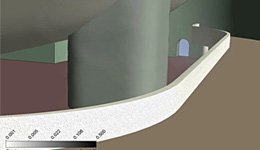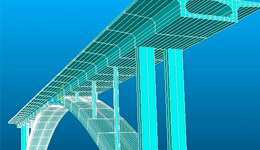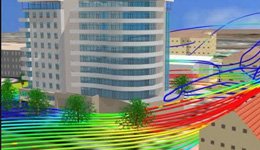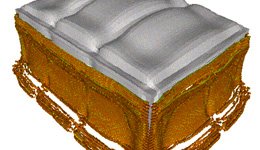Engineering Simulation for the Built Environment

Fire & Smoke Propagation
- Understand the multiphysics phenomena that underlie how fires start, develop and affect a structure
- Analyse the effects of fire and extreme temperature on materials
- Structural deterioration analysis
- Catastrophic events such as explosions
- Enable smoke-management strategies and efficient investigation of fire and smoke management after catastrophic events
ANSYS simulations of smoke and fire propagation offer detailed, reliable representations of real-life scenarios to aid in planning for emergency evacuation and optimal placement of firefighting equipment.

Structural Building Design
- Narrow the scope of field investigations
- Save considerable time and cost on projects
- Move more quickly to the groundbreaking stage
- Projects as diverse as high-rise buildings, bridges, dams and stadiums
- Analyse safety, strength, comfort and environmental considerations
Using ANSYS simulation tools to visualise the effect of a wide range of variables, engineers can narrow the scope of field investigations, save considerable time and cost on projects, and move more quickly to the groundbreaking stage.

Wind Engineering
- Assess the structural load imposed by the wind
- The transport and dispersion of pollutants
- Pedestrian comfort at ground level
- Provide regulatory authorities with vital environmental impact information, particularly if the building falls outside standard design codes
- Reduce the risk of faulty construction and increases the probability of project completion on time and within budget, satisfying all regulatory requirements
ANSYS tools offer engineers a greater understanding of the aerodynamics of structures while providing regulatory authorities with vital environmental impact information, particularly if the building falls outside standard design codes.

HVAC Equipment Design
ANSYS technology incorporates extensive capabilities across multiple disciplines, so engineers can apply mechanical, fluids and multiphysics tools to a wide range of HVAC equipment design, including:
- Air cleaning equipment
- Air conditioners
- Air handlers
- Burner design/boilers
- Chillers
- Diffusers
- Heat exchangers/coils
- Humidifiers/dehumidifiers
- Heating equipment
- Pumps/blowers, fans and compressors/exhausters
- Refrigeration
ANSYS allows tight CAD connections for accessing geometry and material parameters and automatic contact detection offers an easy way to set up testing, giving designers more time to focus on design decisions. See examples of ANSYS HVAC applications here.

Blast, Explosion & Impact
- ANSYS software allows engineers to virtually model various structures and test the impact of environmental and destructive forces as many times as needed to completely understand the effects of a disaster on a structure
- The unequalled depth and unparalleled breadth of simulation software from ANSYS offers engineers many opportunities to optimize building designs to protect them from known yet difficult-to-predict dangers
Through virtual modelling with ANSYS, designers can learn not only what happens to a structure when disaster strikes, but why.


